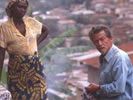Eye For Film >> Movies >> Shooting Dogs (2005) DVD Review
This is the kind of film that can only be made with genuine, uncynical dedication. The DVD, therefore, deserves to be taken seriously, which it is, although two commentaries is always a toughie, because it means watching the film three times.
Co-producer David Belton was a BBC journalist in 1994, during the period of the genocide in Rwanda, and so his involvement is as personal as it is emotionally fraught. He talks of his experiences in the Making Of and how important it was for him to ensure absolute truth, or as close as possible on a shoestring budget. They filmed at the place, in the school, where 2500 Tutsis were massacred after the Belgian UN observers were ordered to leave.

As with most Making Of mini-docs, it is a series of talking heads. John Hurt reminds us that 800,000 people were murdered in 100 days in a country half the size of Scotland. During the filming they had trauma councillors on hand every day, in case any of the extras found the experience of re-enacting scenes that happened here 11 years earlier too upsetting.
In the Research Trip, Belton and Michael Caton-Jones as his cameraman, arrive at the school where they will make the film. Belton gives a guided tour, explaining the lay out and where some of the important scenes took place. He interviews a one-armed man who survived the massacre and it is an astonishing story.
Michael Caton-Jones's commentary is understated, sensitive and well grounded. Having spent over a decade in Hollywood, he appreciated the opportunity to make "a small television film". The BBC wanted him to shoot in South Africa, but he insisted on coming to the place where it happened. "Professional actors mixed in with people who have never acted before in their lives. It keeps the professional actors on their toes because they never know what the others are going to do next. Non-actors are often more fresh."
The restraints of the budget meant that the camera was handheld and they couldn't afford proper lighting. Being on the equator, the sun was directly above and when it started to go down around six o'clock, it went very fast, and because most Rwandans don't have electricity, they tend to go to bed when it gets dark. As a result, many of the non-actors fell asleep during night shoots.
They used 50 extras for all the crowd scenes and kept moving them around so it looked as though there were more. Amateurs took many of the cameo roles. The French captain who arrives to evacuate the whites is played by an accountant Caton-Jones met in a bar and a government official who becomes quite heated in a confrontational scene is a bank manager. Both give excellent performances.
Caton-Jones is full of praise for his extras and all the actors, especially Hurt. He is not an eloquent charmer, full of amusing anecdotes. He is a down-to-earth Scot from Broxburn. On directing Shooting Dogs, he says, "Think hot and act cold and be very disciplined about what you are trying to achieve."
This is a terrific commentary, informative and brutally honest. "It was one of the greatest experiences of my life making this film," he confesses and you know he means it. His first American movie was This Boy's Life, with Robert De Niro and Leonardo DiCaprio. That was good, but this is in a different class.
The second commentary is with Belton and writer David Wolstencroft and is definitely more of a conversation. It brings out the political background to the genocide and the fact that the UN knew in advance what was going to happen and yet, because they were on a Chapter 6 mandate (observers only) and not a Chapter 7, stood back and watched. It must go down in history as one of the great betrayals.
Half way through this commentary track, my DVD corrupted, which meant I missed the juicy bits. Apologies.
Reviewed on: 28 Jul 2006

















